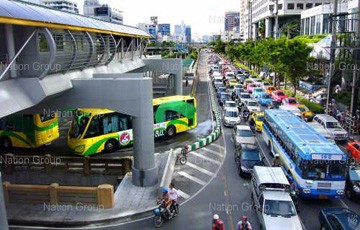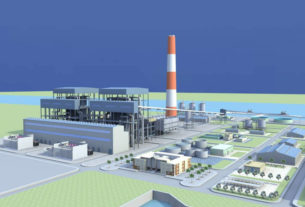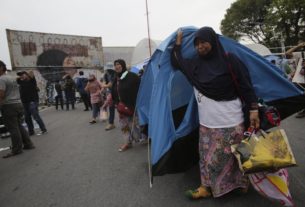Troubled rapid bus route gets deadline
The Bt2-billion Bus Rapid Transit (BRT)’s Sathorn-Rajapreuk route – which was trial-launched in late May – is reported to be facing many problems, and public dissatisfaction has prompted another four routes in the pipeline to be suspended and possibly cancelled.
The Bangkok Metropolitan Administration (BMA) has asked for another four months for the BRT Sathorn-Rajapreuk route to operate before making a decision on whether to cancel it and the other four routes.
After the Sathorn-Rajapreuk route opened on May 29, transporting 20,000 commuters daily, it was reported that 10 per cent of personal car users had shifted to the BRT. However, about 60 per cent of surveyed motorists were not satisfied with the project, said Bangkok Deputy Governor Theerachon Manomaipibul.
The route was to charge a flat fee of Bt10 from September 1 onwards and collect fares ranging from Bt12 to Bt20 after January 2.
The city has now suspended the BRT route, studying procedures on the Mor Chit-Civil Service Complex-Nonthaburi, Sathorn-Suksawat, Don Muang-Min Buri-Suvarnabhumi and Min Buri-Sri Nakarin-Samrong routes.
Theerachon said the problem was that car drivers were not observing traffic laws and some were not familiar with the BRT and the fact that it had its own lane. He said it would take three or four months for people to adjust to this.
Krungthep Thanakom executive Amorn Kitchawengkul said traffic congestion in the
Financially, the BRT route’s break-even point will be Bt180 million to Bt200 million per year, or about Bt15 million per month.
Wat Phraya Krai precinct Colonel Methee Rakpan said the Rama III area had already been notorious for traffic congestion and, after the BRT opened, it had lost one lane while the number of cars remained the same. The traffic police’s short-term solution was to dispatch 20 officers during rush hours to direct traffic at the problematic intersections and to give a green light signal to the side with the largest volume of cars first.
Affirming that police would usually arrest motorists encroaching on the BRT lane, he explained that cars with more than three passengers were allowed to use the route’s sections deemed as “high-occupancy vehicle (HOV) lane”.
A 26-year-old company worker, who gave his first name as Pongsak, said he drove his car to work every day using the Phetkasem-Rama III-Asoke route. As one lane of
The BRT system had also made some spots accident-prone – such as at the
Office worker Wirachada Pengsawang, 40, said she used the BRT service every day from the Rajapreuk station to Wat Dokmai station before taking a motorcycle taxi to her Sathupradit office. Before the BRT, she took a No 205 bus from The Mall Tha Phra, which was very crowded in the morning rush hours. Expressing hope the BRT would be in place in future to help ease traffic jams, she said current problems with the system included waiting times for buses – it often took up to an hour to pass four stations — and the use of their lane by other vehicles.
Another office worker, Arkapong Bopanich, 25, said he used the free BRT ride from the Rajapreuk station to Wat Dokmai every day and found it convenient, except when the bus reached the



